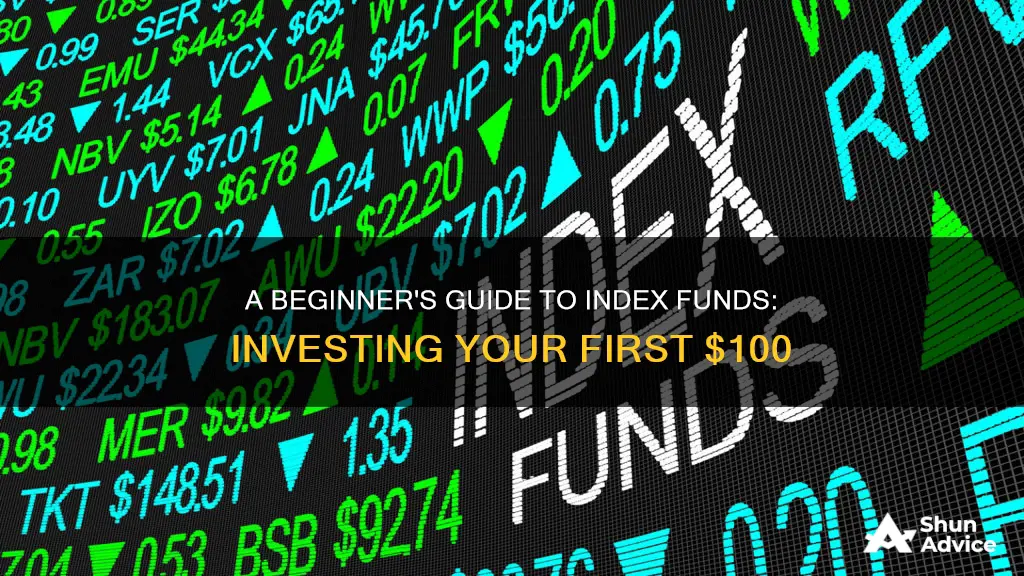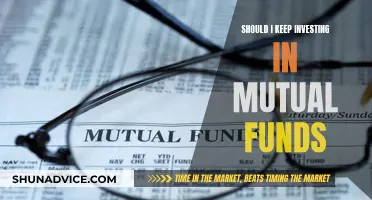
Index funds are a great way to invest $100. They are a low-cost, easy way to build wealth. An index fund is a group of stocks that aims to mirror the performance of an existing stock market index, such as the S&P 500. This means you can invest in an index fund and receive roughly the same return as the market it tracks without any added work on your part. Index funds are popular with long-term investors who are looking for ways to invest passively without having to worry about picking individual stocks. Plus, index funds have secured pretty good returns over the years.
You can purchase an index fund directly from a mutual fund company or a brokerage. The same goes for exchange-traded funds (ETFs). These are like mini mutual funds that trade like stocks throughout the day. When you're choosing where to buy an index fund, consider the fund selection, convenience, trading costs, and impact investing.
Before you start investing in index funds, it's important to know what you want your money to do for you. If you're looking to make a mint in a few years and are willing to take a lot of risks, you may be more interested in individual stocks or even cryptocurrency. But if you're looking to let your money grow slowly over time, particularly if you're saving for retirement, index funds may be a great investment for your portfolio.
| Characteristics | Values |
|---|---|
| Investment minimum | As low as nothing or as high as a few thousand dollars |
| Account minimum | $0 for customers who open a traditional or Roth IRA |
| Expense ratio | Fees subtracted from each fund shareholder’s returns as a percentage of their overall investment |
| Tax-cost ratio | Taxes may be triggered outside tax-advantaged accounts |
What You'll Learn

Index funds vs. mutual funds
Index funds and mutual funds are similar in that they both offer a way to diversify and protect your investments. In fact, most index funds are a type of mutual fund. However, there are some key differences between the two.
Management Style
Index funds are passively managed, meaning they operate without much human intervention. The fund automatically tracks an index such as the S&P 500, and if a stock is in the index, it will be in the fund too. This passive management style allows index funds to charge lower investment advisory fees.
On the other hand, most mutual funds are actively managed. This means that individuals or companies make decisions about which investments to include in the fund based on what they believe will create the best return for investors. Actively managed funds generally have higher fees than passively managed funds due to the cost of paying for the manager's expertise.
Investment Objective
The sole objective of an index fund is to mirror the performance of the underlying index. For example, if the index fund tracks the S&P 500, it will aim to match the returns of that index.
In contrast, the objective of an actively managed mutual fund is to outperform the index and achieve higher returns. The fund manager will try to pick investments they think will beat the market.
Performance and Risk
Over a long enough period, index funds may have a better chance of achieving higher returns than actively managed mutual funds. This is because it is extremely difficult to consistently beat passive market returns (indexes) year after year. However, there are some fund managers who do beat the market, especially in certain market conditions.
Index funds are generally seen as less volatile investments because they are more diversified. However, they give investors less control over their investments. Both types of funds are subject to the risk of loss, and the investment return and principal value of an index fund will fluctuate over time.
Fees and Taxes
As mentioned earlier, index funds tend to have lower fees than actively managed mutual funds due to their passive management style. These lower fees can sometimes result in higher returns for investors, even if the fund does not beat the market. Additionally, index funds tend to be more tax-efficient, although some mutual fund managers employ tax management strategies to offset this advantage.
American Funds: Which Investment Companies to Look For?
You may want to see also

Index funds vs. ETFs
Index funds and ETFs (exchange-traded funds) are similar in many ways. Both are passively managed investment vehicles that aim to replicate the performance of a financial market index, such as the S&P 500. They are also both large, professionally managed portfolios that pool investors' money and tend to keep expense ratios low. However, there are some key differences between the two.
Trading Mechanism
The main difference between index funds and ETFs is their trading mechanism and flexibility. Index funds can only be bought and sold at the end of the trading day, based on the fund's net asset value (NAV). In contrast, ETFs trade throughout the day on a stock exchange, just like stocks, with their price fluctuating based on supply and demand. This means that with index funds, you can only buy and sell shares at the end of the day, whereas with ETFs, you have the flexibility to buy and sell shares at any time during the trading day.
Minimum Investment
Another difference lies in the minimum investment requirements for each. Some index funds have minimum investment amounts, which could range from a few hundred to a few thousand dollars. ETFs, on the other hand, typically do not have minimum investment requirements beyond the price of one share, and fractional shares are often available, making them more accessible to investors with limited capital.
Taxation
ETFs and index funds also differ in terms of taxation. ETFs are generally more tax-efficient than index funds due to their structure and creation and redemption processes. ETFs have lower capital gains distributions because they can conduct in-kind redemptions, which help to minimise taxable events. In contrast, index funds generate capital gains distributions from buying and selling securities within the fund, resulting in higher tax liabilities for investors.
Fees
When it comes to fees, both index funds and ETFs have lower expense ratios than actively managed funds. However, with ETFs, you may also owe a trading commission or a bid-ask spread, depending on your broker. Index funds, on the other hand, typically do not have these additional fees, but they may have redemption fees, which are paid when shares are sold.
Suitability
The suitability of each investment vehicle depends on your individual needs and goals. ETFs are generally better for frequent trading due to their flexibility and intraday trading capability. They are also a good option for those looking to reduce their tax liability. Index funds, on the other hand, could be more suitable for long-term investors who are not concerned with intraday trading and are looking for a simple, low-cost investment option.
ETFs: Diversified, Low-Cost, and Easy to Trade
You may want to see also

Index fund investment minimums
Index funds are a type of mutual or exchange-traded fund (ETF) that tracks the performance of a market index, such as the S&P 500, by holding the same stocks or bonds or a representative sample of them. They are defined as investments that mirror the performance of benchmarks like the S&P 500 by mimicking their makeup.
Index funds are popular among investors because they offer a simple, no-fuss way to gain exposure to a broad, diversified portfolio at a low cost. They are passively managed, which means they have lower expenses and fees than actively managed funds. This makes them ideal for long-term investing, such as retirement accounts.
When it comes to investing in index funds, there are two main approaches: self-directed research and seeking professional advice. If you choose to invest on your own, it's important to educate yourself on index fund investing principles, stay informed about market trends and tax implications, and regularly review and adjust your portfolio. On the other hand, consulting a financial advisor can guide you in selecting a fund that aligns with your financial goals and ensures your portfolio is well-diversified.
- Vanguard 500 Index Fund Admiral Shares (VFIAX): This fund has a minimum investment of $3,000 and an expense ratio of 0.04%.
- Fidelity ZERO Large Cap Index Fund (FNILX): This fund has a 0% expense ratio and no minimum investment requirement.
- Fidelity 500 Index Fund (FXAIX): While the minimum investment amount is not specified, this fund is mentioned as having no minimum investment requirement.
- Robo-advisors: These digital investment platforms often have no account minimum. Popular robo-advisors include Ellevest, Axos Invest, and Betterment, among others.
In summary, index funds offer a low-cost, diversified, and passive investment option that has gained popularity due to their consistent performance. When considering index fund investment minimums, it's important to research the specific requirements of the fund you're interested in, as they can vary across different funds and platforms.
Mutual Funds vs. IRA: Why Opt for Mutual Funds?
You may want to see also

Index fund expense ratios
Index funds are a type of investment fund that replicates the performance of a specific market index, such as the S&P 500. They are considered a passive form of investing, as the portfolio managers of these funds buy and hold a representative sample of the securities in the target index, only making changes if the index itself changes. This passive management style generally results in index funds having lower expense ratios compared to actively managed funds.
An expense ratio is the fee that you pay to an investment fund each year. It is calculated by dividing a fund's operating expenses by the average total dollar value of all the assets in the fund, and it is expressed as a percentage of the fund's average net assets. For example, an expense ratio of 0.47% would equate to $47 for every $10,000 invested. These fees are taken out of the fund's total value on a regular basis and directly reduce your investment returns.
When it comes to index funds, the expense ratio covers the costs of portfolio management, administration, marketing, and distribution, among other expenses. As index funds are passively managed, they generally have lower expense ratios compared to actively managed funds, which require more expertise and a more active approach to investing. Actively managed funds may increase or decrease their exposure to individual stocks or sectors, requiring more research and analysis, which results in higher costs.
The expense ratio of an index fund will depend on the specific fund and its assets. The largest ETF, the SPDR S&P 500 ETF Trust (SPY), has a fairly high expense ratio for an ETF of 0.0945%. In contrast, some index funds based on the S&P 500 index charge fees below 0.10%, and some are even free.
When choosing an index fund or any other type of investment fund, it is essential to consider the expense ratio as it can significantly impact your returns over time. A lower expense ratio is generally preferable, as it means lower fees and higher potential returns. However, it is also important to consider other factors, such as the fund's performance and whether it aligns with your investment goals.
Loaded Fee Mutual Funds: When to Invest and Why
You may want to see also

Index fund tax-cost ratios
Index funds are a great way to invest small sums of money. They are a powerful wealth-building tool, offering instant diversification and a long history of making money for investors who can hold for a decade or longer.
When considering how to invest $100 in index funds, it is important to be aware of the tax-cost ratio, which is a measure of how much a fund's annualised return is reduced by the taxes investors pay on distributions. This is an often-overlooked aspect of investing, but it can have a significant impact on investment performance and should not be ignored.
The tax-cost ratio is calculated by Morningstar for products such as mutual funds and Exchange-Traded Funds (ETFs). It is influenced by the number of distributions a fund makes, with more distributions generally leading to a larger tax-cost ratio and a larger amount of the return lost to taxes. This is known as "tax drag".
The tax-cost ratio also depends on the types of distributions, which are taxed at different rates. Non-qualified dividends, short-term capital gains, and interest income are taxed at a higher rate than qualified dividends and long-term capital gains. Municipal bond interest and unrealized capital appreciation are generally taxed at a rate of 0%.
While the tax-cost ratio is not commonly discussed, it can represent a significant hidden cost for investors, and it is important to be aware of it when making investment decisions. It is a key factor in determining the level of a fund's tax efficiency and can help investors make more informed choices about where to allocate their money.
By understanding the tax-cost ratio and its potential impact on investment returns, investors can make more informed decisions about how to allocate their funds, including when investing $100 in index funds.
Vanguard Funds: Exploring India-Centric Investment Opportunities
You may want to see also
Frequently asked questions
You can start investing in index funds with $100 by opening an investment account, such as a brokerage account, individual retirement account (IRA), or Roth IRA. You can then use this account to purchase shares of an index fund. When choosing an index fund, consider factors such as the company size, geography, business sector, and asset type. It is also important to remember that index funds are a long-term investment strategy, so make sure you are comfortable with the level of risk and have a financial plan in place.
Index funds offer a low-cost, easy way to build wealth over the long term. They are less expensive than actively managed funds and typically carry less risk than individual stocks. Index funds are also a great way to diversify your investments, as they allow you to invest in a variety of companies and sectors.
Some popular index funds include the Vanguard S&P 500 Index Fund (VOO), which tracks the S&P 500 index, and the SPDR S&P 500 ETF (SPY), which is an exchange-traded fund (ETF) that also tracks the S&P 500. These funds offer a simple and affordable way to invest in a diverse range of stocks.
If you are looking for alternative investment options, you can consider investing in fractional shares of stock, opening a high-yield savings account, or using a robo-advisor platform. You can also invest in cryptocurrencies, real estate, or dividend-paying stocks. Remember to always do your own research and understand the risks involved before investing.







